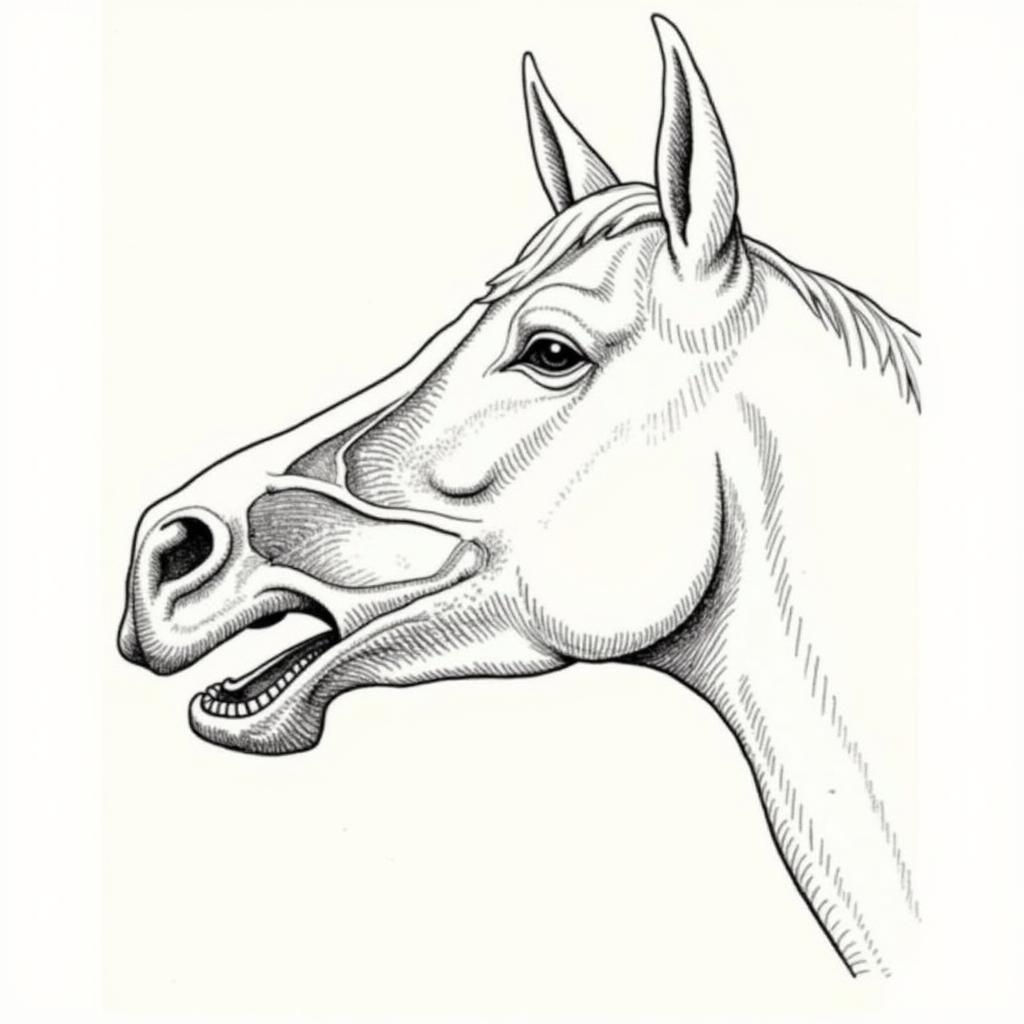Tie Back Surgery For Horses is a procedure performed to correct laryngeal hemiplegia, a condition commonly known as “roaring.” This article will delve into the intricacies of tie back surgery, exploring its purpose, procedure, recovery process, and potential complications. We’ll provide you with all the information you need to make informed decisions about your horse’s health.
Understanding Laryngeal Hemiplegia and the Need for Tie Back Surgery
Laryngeal hemiplegia, or roaring, is a respiratory condition affecting horses, particularly larger breeds and Thoroughbreds. It’s characterized by paralysis of the left arytenoid cartilage in the larynx, which obstructs airflow into the trachea. This obstruction produces the characteristic “roaring” sound during exercise. The condition can range from mild to severe, impacting a horse’s performance and overall well-being.  Diagram of Horse Laryngeal Hemiplegia
Diagram of Horse Laryngeal Hemiplegia
When conservative management methods fail to provide adequate relief, tie back surgery becomes a viable option. This surgical procedure aims to permanently “tie back” the affected arytenoid cartilage, widening the airway and improving airflow. While not a cure, tie back surgery significantly improves the horse’s ability to breathe during exercise, allowing them to return to work in many cases.
The Tie Back Surgery Procedure: What to Expect
The tie back surgery involves making an incision in the horse’s neck, just behind the jawbone, to access the larynx. The paralyzed arytenoid cartilage is then sutured to a nearby muscle or cartilage, permanently holding it in an abducted position. This opens the airway and allows for improved respiration. check ligament injury in horses
The procedure is typically performed under general anesthesia and takes about one to two hours. Following the surgery, the horse will require a period of recovery and rehabilitation.
Post-Operative Care and Recovery from Tie Back Surgery
After tie back surgery, horses require careful post-operative care. This includes pain management, administration of antibiotics to prevent infection, and strict rest. The horse will typically stay at the veterinary clinic for a few days following the surgery for monitoring. Once discharged, stall rest is crucial for several weeks to allow the surgical site to heal.
A gradual return to exercise is essential. This usually begins with hand-walking and gradually progresses to riding. The full recovery period can take several months, and the veterinarian will guide the rehabilitation process based on the individual horse’s progress.
“Post-operative care is paramount for a successful outcome following tie back surgery. Careful monitoring, pain management, and a gradual return to exercise are crucial,” advises Dr. Emily Carter, DVM, a renowned equine surgeon.
Potential Complications and Long-Term Outcomes of Tie Back Surgery
While generally safe and effective, tie back surgery, like any surgical procedure, carries potential risks. These include infection, suture failure, and aspiration pneumonia.
“Choosing a skilled and experienced equine surgeon is essential for minimizing potential complications and ensuring a positive outcome,” adds Dr. Carter.
Long-term, most horses experience significant improvement in their respiratory function after tie back surgery. They can often return to their previous level of activity, although some limitations might apply depending on the severity of the initial condition.
Is Tie Back Surgery Right for My Horse?
Deciding whether tie back surgery is the appropriate course of action for your horse requires careful consideration. Factors to consider include the severity of the roaring, the horse’s age, overall health, and intended use. Consulting with an experienced equine veterinarian is crucial for making an informed decision.
best anti inflammatory for horses
“A thorough examination, including endoscopic evaluation of the larynx, is necessary to assess the extent of the paralysis and determine the best treatment approach,” explains Dr. James Miller, DVM, a board-certified specialist in equine internal medicine.
Conclusion
Tie back surgery for horses offers a viable solution for managing laryngeal hemiplegia. By addressing the underlying cause of roaring, this procedure can significantly improve a horse’s respiratory function and quality of life. Understanding the procedure, recovery process, and potential complications is essential for making informed decisions about your horse’s care. Always consult with your veterinarian to determine the best course of treatment for your horse’s specific needs. Remember, a well-informed owner is a horse’s best advocate.
FAQ
-
What is the success rate of tie back surgery in horses?
-
How long does a horse need to stay at the vet clinic after tie back surgery?
-
What are the signs of infection after tie back surgery?
-
When can a horse return to riding after tie back surgery?
-
What are the alternative treatments for roaring in horses besides tie back surgery?
-
How much does tie back surgery for horses typically cost?
-
What are the long-term management strategies for a horse that has undergone tie back surgery?
Need further assistance? Please contact us at Phone Number: 0772127271, Email: [email protected] or visit our address: QGM2+WX2, Vị Trung, Vị Thuỷ, Hậu Giang, Việt Nam. We have a 24/7 customer support team.